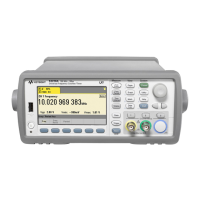The READ? command places the instrument in the "wait-for-trigger" state, initiates a measurement when
the rear-panel Trig In BNC is pulsed (low by default), stores the measurement in memory, and then trans-
fers the measurement to the instrument's output buffer. The default measurement configuration is used
for the measurement.
CONF:FREQ
TRIG:SOUR EXT
READ?
Typical Response: +4.27150000000000E+006
The following program segment is similar to the previous example but it uses the INITiate command to
place the instrument in the "wait-for-trigger" state. The INITiate command places the instrument in the
"wait-for-trigger" state, initiates a measurement when the rear-panel Trig In BNC is pulsed (low by
default), and sends the measurement to reading memory. The FETCh? command transfers the meas-
urement from reading memory to the instrument's output buffer.
CONF:FREQ
TRIG:SOUR EXT
INIT
FETC?
Typical Response: +4.27380000000000E+006
Storing measurements in memory using the INITiate command is faster than sending measurements to the
output buffer using the READ? command (provided you do not send the FETCh? command until done).
The INITiate command is also an "overlapped" command. This means that after executing the INITiate com-
mand, you can send other commands that do not affect the measurements. This allows you to check for
data availability before initiating a read attempt that might otherwise time out. Note that the FETCh?
command will wait until all measurements are complete to terminate. The instrument can store up to
1,000,000 measurements in internal reading memory.
The following program segment configures the instrument for frequency measurements, triggers the
instrument to make one measurement using the INITiate command, and then stores the measurement in
memory.
CONF:FREQ 1.2E6,1
INIT
FETC?
Typical Response: +1.23239300000000E+006
CONFigure Subsystem Introduction
114 Keysight 53220A/53230A Programmer's Reference

